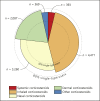Systemic and Local Corticosteroid Use Is Associated with Reduced Executive Cognition, and Mood and Anxiety Disorders
- PMID: 31220843
- PMCID: PMC7114901
- DOI: 10.1159/000501617
Systemic and Local Corticosteroid Use Is Associated with Reduced Executive Cognition, and Mood and Anxiety Disorders
Abstract
Background: Use of local corticosteroids, especially the inhaled types, has increasingly been associated with systemic uptake and consequent adverse effects. In this study, we assessed the associations between the use of different corticosteroid types with cognitive and neuropsychiatric adverse effects related to high glucocorticoid exposure.
Methods: In 83,592 adults (mean age 44 years, 59% women) of the general population (Lifelines Cohort Study), we analyzed the relationship between corticosteroid use with executive cognitive functioning (Ruff Figural Fluency Test), and presence of mood and anxiety disorders (Mini-International Neuropsychiatric Interview survey). We performed additional exploration for effects of physical quality of life (QoL; RAND-36), and inflammation (high-sensitive C-reactive protein [CRP]).
Results: Cognitive scores were lower among corticosteroid users, in particular of systemic and inhaled types, when compared to nonusers. Users of inhaled types showed lower cognitive scores irrespective of physical QoL, psychiatric disorders, and high-sensitive CRP. Overall corticosteroid use was also associated with higher likelihood for mood and anxiety disorders. Users of inhaled corticosteroids were more likely to have mood disorders (OR 1.40 [95% CI 1.19-1.65], p < 0.001) and anxiety disorders (OR 1.19 [95% CI 1.06-1.33], p = 0.002). These findings were independent of physical QoL. A higher likelihood for mood disorders was also found for systemic users whereas nasal and dermal corticosteroid users were more likely to have anxiety disorders.
Conclusions: Commonly used local corticosteroids, in particular inhaled types, and systemic corticosteroids are associated with reduced executive cognitive functioning and a higher likelihood of mood and anxiety disorders in the general adult population.
Keywords: Anxiety disorders; Brain; Cognition; Corticosteroids; Glucocorticoids; Mood disorders.
The Author(s). Published by S. Karger AG, Basel.
Conflict of interest statement
The authors declare that they have no conflicts of interest to disclose.
Figures


References
-
- Lindholm J, Juul S, Jørgensen JO, Astrup J, Bjerre P, Feldt-Rasmussen U, et al. Incidence and late prognosis of cushing's syndrome: a population-based study. J Clin Endocrinol Metab. 2001 Jan;86((1)):117–23. - PubMed
-
- Raofi S, Schappert SM. Medication therapy in ambulatory medical care: united States, 2003-04. Vital Health Stat 13. 2006 Dec;((163)):1–40. - PubMed
-
- Broersen LH, Pereira AM, Jørgensen JO, Dekkers OM. Adrenal insufficiency in corticosteroids use: systematic review and meta-analysis. J Clin Endocrinol Metab. 2015 Jun;100((6)):2171–80. - PubMed
Publication types
MeSH terms
Substances
LinkOut - more resources
Full Text Sources
Medical
Research Materials
Miscellaneous

